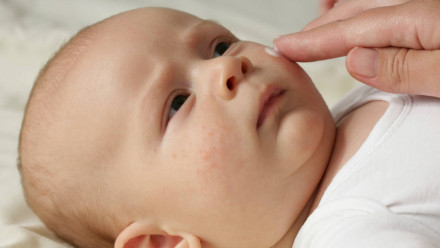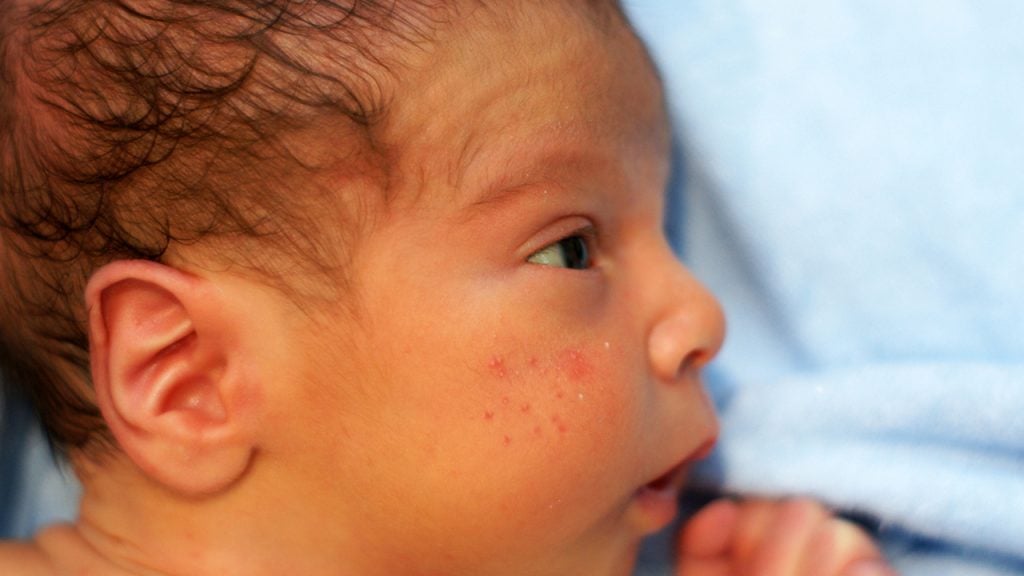Photo: iStockphoto
Katie Green’s daughter had flawless skin, so she was surprised when her second child, Charlie, developed what looked like baby acne at just 10 days old. “It started with redness on the cheeks, and then some whiteheads started appearing in clusters,” says Green. “It would be really bad on one side, and then it would go away and be really bad on the other side.”
After asking her mom and searching online for answers, Green realized that she was probably dealing with neonatal acne, and her suspicions were confirmed when she visited her doctor at a two-week check-up. She also received plenty of reassurance when she posted about the issue on social media. “A lot of moms said, ‘Don’t worry—we had that,’ and gave me a lot of really good advice,” she says.
While neonatal acne can look alarming, it’s actually very common, affecting up to one in five babies. But there’s another type of acne, called infantile acne, that happens at a different stage in a child’s development and can be more severe.
What’s the difference between neonatal acne and infantile acne?
When someone says their infant has “baby acne,” they’re typically referring to a common condition known as neonatal acne (neonatal cephalic pustulosis). It isn’t what we commonly think of as acne that presents as pimples, blackheads and whiteheads due to clogged pores. Infantile acne, on the other hand, occurs later in life and is a true form of acne that’s found in young children. Here’s how to differentiate between the two.
Neonatal acne symptoms
● Appears at about two or three weeks of age
● Lasts for a few weeks to a few months
● Affects 20 percent of children
● Looks like red, inflamed bumps and pimples and may be found on the cheeks, forehead, chest and back
● Will not cause scarring
Infantile acne symptoms
● Appears at about three months
● Lasts for a few months or up until ages two or three
● Affects less than two percent of children
● Looks like teenage acne, with pimples, blocked pores and blackheads
● May cause scarring
What’s the cause of baby acne?

An age-by-age guide to skin rashes and conditionsThere is no known definitive cause for neonatal acne and infantile acne. “Neonatal acne may be due to the transfer of maternal hormones—particularly the “male” hormone androgen—toward the end of pregnancy,” says Yenge Diambomba, a staff neonatologist and clinical director of nurseries at Mount Sinai Hospital in Toronto. Wingfield Rehmus, a paediatric dermatologist at BC Children’s Hospital in Vancouver, suggests that yeast may play a role. “Neonates tend to have a form of yeast called Malassezia in higher rates than people at other ages,” she says. “It’s part of the changes in the normal flora of yeast and bacteria that live on our skin.”
When it comes to infantile acne, there are higher than normal levels of hormones at play. There also seems to be a genetic component. “In their family history, you may find that one of the parents had issues with severe acne during their childhood,” says Diambomba.
How do I know it’s not eczema, milia or some other type of rash?
Since there are many skin conditions that can affect a child, it may be hard for a parent to differentiate between acne and other skin concerns. Here are a few telling details for common skin issues in infants.
Eczema: Unlike acne, eczema is patchy, with more scales than individual pimples.
Milia: These small white bumps appear under the skin but don’t have any redness around them. Because they are little cysts and not filled with pus, they won’t pop like pimples.
Miliaria crystallina: A mild form of heat rash, miliaria crystallina develops when blocked pores trap sweat under the skin. “It’s more transient, but it looks similar to baby acne,” says Rehmus.
Erythema toxicum: This common rash is more widespread around the body than baby acne. “Each of the bumps has more of a blush around the back of it,” says Rehmus. “It’s a benign rash that goes away by itself.”
Viral infection: “You can have rashes with viral infections, but you’ll notice a difference in the behaviour of the child,” says Diambomba. “They may not eat with as much enthusiasm, have different stools or have a fever.”
How do I treat baby acne?
For neonatal acne, the best course of action is to simply take a deep breath and let it be. “Parents may try all sorts of lotions and soaps to try to make it disappear, but they can exacerbate already sensitive skin,” says Diambomba. “Most of the time, you should just leave it alone and keep it dry and it will go away on its own.” If you’re really concerned, check with your family doctor, who may recommend a low-potency cortisol to calm inflammation, along with topical anti-yeast medicines, such as clotrimazole and tioconazole, says Rehmus.
Since infantile acne lasts longer and can cause scarring, it’s a good idea to request a referral to a dermatologist for an assessment. “Infantile acne is treated like typical teenage acne but with more gentle preparations because of the age of the child,” says Rehmus. “This may include topical retinoids, antibiotics and benzoyl peroxide. When it’s severe enough, babies at risk of scarring will be treated with oral medication.”
A final bit of good news for neonatal acne
For parents dealing with neonatal acne, they can rest assured that this common skin condition isn’t painful. “The child is not inconvenienced,” says Diambomba. “Actually, it bothers the parents more because that’s when people often take a lot of pictures.”
Green was worried about her son’s comfort at first. “You feel bad,” she says. “It looks angry because it’s so red, but it doesn’t affect them at all.”
Three weeks after onset, Green found that Charlie’s skin had mostly cleared up. “I ended up doing the path of least resistance,” she says. “Every morning, I would clean his face with a warm compress and dry it really well. I didn’t put anything on it. I thought it would figure itself out.”
Read more:
What you need to know about baby birthmarks
4 things you should know about hemangioma


